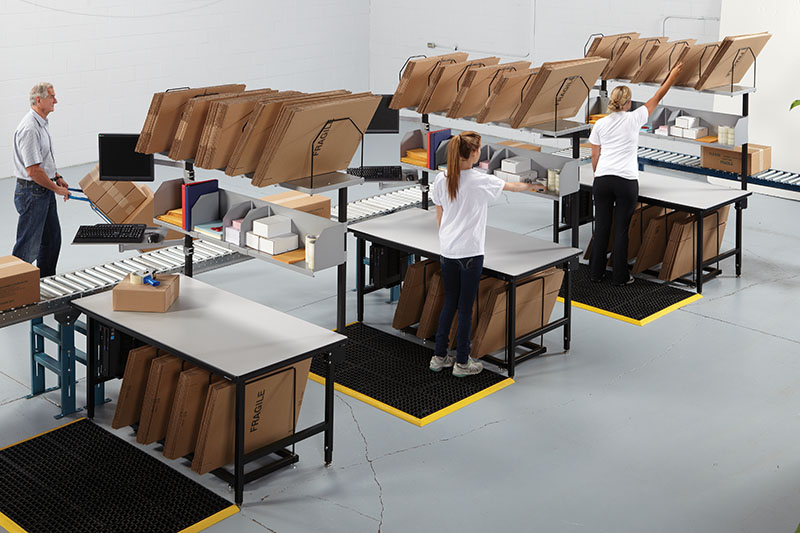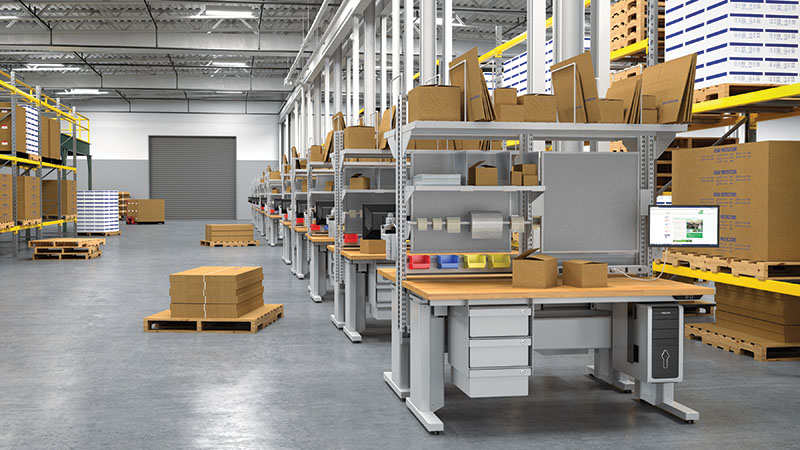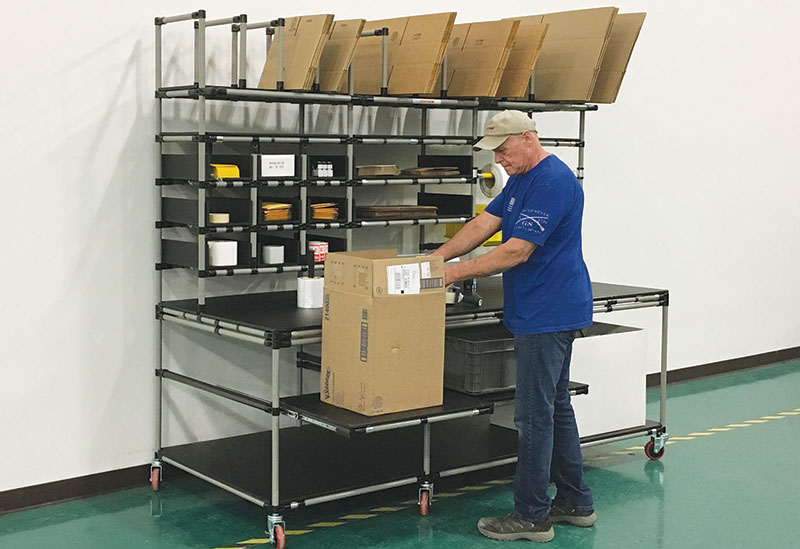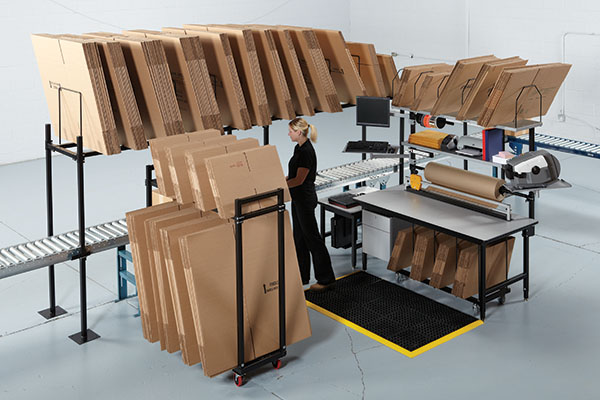Putting the power of the packing station into users’ hands
As the demands of e-commerce, omni-channel and a tight labor market continue to impact companies across most industries, the packing station becomes a focal point for efficiency and worker ergonomics in warehouses and DCs nationwide.
Pull up Pro-Line’s 3D Build a Bench tool and the first thing you see are some color choices, followed by bench type, depth and myriad options ranging from overhead light frames to bin holders to keyboard trays. Click through the options—turning them on and off as desired—and the adjacent 3D picture changes to reflect your preferences. The end result is a completely customized packing station designed for a specific warehouse or DC.
“They get to spin it around; look at the product from above and below; and add accessories,” says Bob Simmons, senior vice president at Pro-Line. “We’re usually working with industrial engineers or facilities managers who just copy and paste the configured designs into their own programs and use them to justify the project costs,” Simmons continues. “In this instant world we live in, they don’t have to ask for drawings and then wait around for them. They can just go online and do it themselves.”
Pro-Line’s 3D configurator is just one example of how personalized and optimized the modern-day packing station has become. No longer just folding tables where boxes are packed and supplies are stored, these important warehouse components are built to withstand the rigors of e-commerce, omni-channel distribution, temporary workforces, and anything else the ever-evolving fulfillment world can throw at them.
Don’t get it wrong
In today’s environment, the company that gets picking and packing wrong can be hit with productivity slowdowns, cost increases and customer service problems, among other challenges. Similar in function, but often unique to their specific environments, packing stations support the picking and packing process and help streamline product flow through warehouses and DCs.
They also serve as central “hubs” for workers, enable multiple tasks to be handled in one work area, and provide ergonomic benefits for users. The modern-day packing station looks much different than its predecessors. For example, even the core work surface itself has evolved over the last few years.
“In the past, people just ordered laminate or wood tables,” says Simmons. “Today, we’re making five different work surfaces.” The newest options include stainless steel, chemical-resistant, epoxy resin and ESD (electro-static dissipative) laminate, the latter is used by companies packaging electronic components that are sensitive to static electricity. At Dehnco Equipment & Supply Co., president Jeff Dehnert says more companies are looking to their packing stations to provide a mix of efficiency and ergonomics.
With good workstation design, he says, customers are finding the right balance between the two. When making the equipment, Dehnert says the manufacturer factors in the many different types of packaging that a company might be using. This is critical, he says, due to the high velocity of smaller orders—not all of which are on pallets, in cases, or even boxed—moving through the typical DC or warehouse right now.

“We’re integrating different pieces of equipment and then organizing them in a way that minimizes the number of human touches and worker movement needed to get the task completed,” says Dehnert. “It’s about making things easy, non-repetitive, and non-stressful to the person who is doing the packing.” Process is equally as important, he adds, as companies focus more and more on efficiency improvements.
“With less touches and not having to move things around as much, we’re helping to create a more efficient process overall,” says Dehnert. From there, Dehnco looks at how to integrate all of these elements and requirements into the best possible packing station setup. For example, that could mean adding computer monitors, keyboards, scanners, printers and automated equipment (e.g., air pillow, paper or pack-on-demand systems) to the unit.
“A lot of companies will spend the money on software, hardware and equipment automation, only to send that automated process off to a manual packing station,” says Dehnert. “If that station isn’t integrated properly, it can become a bottleneck that reduces return on investment (ROI).”
One size doesn’t fit all
In today’s competitive global business environment, companies must maintain and improve quality, accuracy and productivity throughout their operations. While automation has made great advances, many tasks still remain that are being performed by human operators, and often these tasks are the more difficult and repetitive ones.
“Designing a work environment for today’s diverse workforce that reduces repetitive motions, awkward postures and heavy lifting is an essential factor in reducing operator strain and injury all while improving productivity,” says Rob Doucette, applications engineer with BOSTONtec. “In today’s world, one size certainly does not ‘correctly’ fit all.”

In the warehouse environment, Doucette says he’s seeing an increasing demand for electric-height adjustable workstations. For example, many companies incorporate multi-shift, multi-user operations that use the same workstation for multiple operators. BOSTONtec’s electric height-adjustable workstations let operators adjust the stations height for a proper work posture.
Using a push-button control switch (which comes standard), operators can see the exact height of their work surfaces and save their preferred height settings. “This makes it easy to correctly set the workstation to the individual’s proper height,” Doucette says, noting that the feature is especially useful in sit/stand environments or multi-user operations. He says companies should also consider the placement of specific items within the packing workspace.
Operators need adequate space to perform certain tasks, for example, so the best approach is to remove anything from the work area that doesn’t immediately pertain to the task (while keeping items that do within easy reach). “With increasing awareness in this design aspect, we’ve developed different under-work surface solutions to help clear the work surface and still maintain convenient access to tools and supplies,” Doucette explains.
BOSTONtec’s full-extension under work surface printer pull-outs keep printers off the work area, for example, and use a similar approach with under-work surface shelving used for packing larger boxes. When warehouse managers are designing the work process with workstations, Doucette says the manufacturer always recommends reviewing the task with the workstation supplier in detail.
“There are many efficient and clever ideas that can be customized on the workstation,” he adds, “to make the process much more ergonomically sound and thus less stressful for the worker.”
Creating efficient processes
With warehouses becoming more and more automated, the pressure is on to create packing stations that help to harmonize the marriage of human beings and automation. “Even though warehouses are more automated, the packing and packaging processes are still very manual in nature,” says Keith Soderlund, vice president of sales at Creform Corp.
Knowing this, he says manufacturers focus on how to speed up the packing process, optimize packages for shipping and reduce freight costs. This triad isn’t always easy to achieve. “There are software systems that can look at the order and pick a box,” says Soderlund, “but it’s really up to the operators to get the right box and put it all together. When they have the materials close at hand, and when they can stay in their respective areas and get the job done, throughput usually goes up.”

That’s music to the ears of e-commerce distributors that carefully track metrics like throughput, knowing that the more optimized an order is, the higher profitability will be. To help customers hit profitability targets, Creform takes a flexible, modular approach to packing station design that goes beyond just “plug and play” and then hope the solution works.
“We want to offer the optimum product for today, while also giving users the ability to change and adapt as their companies evolve,” says Soderlund. “The reality is that many companies invest in packing stations, thinking they’ve got it nailed. But once the products arrive onsite and are installed—and once the operator feedback starts to come in—changes need to be made.”
The problem is that most warehouse and DC operations are pretty light on engineering staff,” says Soderlund, and warehouse managers are responsible for numerous locations. “Everyone is spread pretty thin right now,” he points out. “That’s where our experience comes into play as we try and make sure that we fill in any gaps that customers have in terms of technical need.”
Giving them ownership
As e-commerce continues to expand, and as the intricacies of running a profitable fulfillment operation grow exponentially, Soderlund expects packing stations to play an even bigger role in these operations. “E-commerce is growing, freight rates are going up and labor is getting more expensive and harder to find,” he says. “The need for workstations that enable operator comfort and efficiency—all while giving them some ownership of the workspace—will only increase.”













